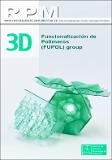Por favor, use este identificador para citar o enlazar a este item:
http://hdl.handle.net/10261/296809COMPARTIR / EXPORTAR:
 SHARE
BASE SHARE
BASE
|
|
| Visualizar otros formatos: MARC | Dublin Core | RDF | ORE | MODS | METS | DIDL | DATACITE | |

| Campo DC | Valor | Lengua/Idioma |
|---|---|---|
| dc.contributor.author | Mercado, Jorge | es_ES |
| dc.contributor.author | Esteban-Arranz, Adrián | es_ES |
| dc.contributor.author | Hernández-Sosa, Alejandro | es_ES |
| dc.contributor.author | López-Rubio, Amparo | es_ES |
| dc.contributor.author | Martínez Abad, Antonio | es_ES |
| dc.contributor.author | Hernández, Rebeca | es_ES |
| dc.contributor.author | Bojorges, Hylenne | es_ES |
| dc.contributor.author | Fabra, María José | es_ES |
| dc.date.accessioned | 2023-03-07T10:20:12Z | - |
| dc.date.available | 2023-03-07T10:20:12Z | - |
| dc.date.issued | 2022 | - |
| dc.identifier | issn: 0034-8708 | - |
| dc.identifier.citation | Revista de Plasticos Modernos vol124 numero 784: 19- 23 (2022) | es_ES |
| dc.identifier.uri | http://hdl.handle.net/10261/296809 | - |
| dc.description.abstract | El alginato es un polímero de origen natural que gelifica rápidamente a temperatura ambiente en presencia de cationes divalentes, ampliamente utilizado en impresión 3D por extrusión. En este trabajo se emplearon tres alginatos con diferentes características estructurales, uno comercial y dos extraídos en el laboratorio para la preparación de biotintas de alginato. Para la preparación de las biotintas, se entrecruzaron los alginatos con diferentes concentraciones de cloruro cálcico. Los resultados obtenidos mediante pruebas de vial invertido y medidas de flujo mostraron que el alginato con relación menor M/G dio lugar a biotintas con mayores valores de viscosidad a menores concentraciones de cloruro cálcico. Este trabajo pretende demostrar la gran influencia que la estructura del alginato tiene sobre la preparación de biotintas que puedan ser utilizadas para la producción de andamios por impresión 3D. | es_ES |
| dc.description.abstract | Alginate is a natural polymer with a fast gelation process at room temperature in the presence of divalent cations, which is widely used in 3D printing by extrusion. In this work, three different alginates with different structural characteristics, one commercial and two extracted in the lab from algae were used to prepare alginate bioinks. These bioinks were crosslinked with different concentrations of CaCl2. Results from the inverted vial and flow measurements allowed to conclude that alginate with the lowest M/G ratio gave rise to bioinks with higher viscosity at lower concentrations of CaCl2. This work demonstrates the influence that the alginate structure possesses for the generation of bioinks that will be used to produce scaffolds by 3D printing technique. | es_ES |
| dc.description.sponsorship | Los autores agradecen la financiación economica del MICINN (PID2020-113045GB-C22 y RTI-2018-094268-B-C22). Adrián Esteban-Arranz agradece el contrato financiado por la Plataforma Temática Interdisciplinar del CSIC, SusPlast: Plataforma Interdisciplinar de Plásticos Sostenibles para una Economía Circular. Hylenne Bojorges agradece el contrato Santiago Grisolía de la Generalitat Valenciana (GRISOLIAP/2019/007) | es_ES |
| dc.language | spa | - |
| dc.publisher | Asociación para el Fomento de la Ciencia y de la Técnica | es_ES |
| dc.relation | info:eu-repo/grantAgreement/AEI/Plan Estatal de Investigación Científica y Técnica y de Innovación 2017-2020/PID2020-113045GB-C22/ES/DESDE NUEVOS GELES POLIMERICOS INDUCIDOS POR CRISTALIZACION HASTA EL DESARROLLO DE SUS POTENCIALES APLICACIONES EN IMPRESION 3D/ | es_ES |
| dc.relation | info:eu-repo/grantAgreement/AEI/Plan Estatal de Investigación Científica y Técnica y de Innovación 2017-2020/RTI2018-094268-B-C22/ES/MEJORA DE LAS PROPIEDADES TECNOLOGICAS Y NUTRICIONALES DE ALIMENTOS UTILIZANDO GELES Y EMULSIONES FORMADOS A PARTIR DE CARBOHIDRATOS NO PURIFICADOS OBTENIDOS DE FUENTES ALTERN/ | es_ES |
| dc.relation | info:eu-repo/grantAgreement/Generalitat Valenciana//GRISOLIAP/2019/007 | es_ES |
| dc.relation.isversionof | Publisher's version | es_ES |
| dc.rights | openAccess | es_ES |
| dc.subject | alginato, estructura, biotinta, viscosidad, impresión 3D. | es_ES |
| dc.title | Biotintas de alginato para impresión 3D: efecto de la estructura en sus propiedades reológicas | es_ES |
| dc.type | artículo | es_ES |
| dc.description.peerreviewed | Peer reviewed | es_ES |
| dc.date.updated | 2023-03-07T10:20:12Z | - |
| dc.contributor.funder | Ministerio de Ciencia e Innovación (España) | es_ES |
| dc.contributor.funder | Consejo Superior de Investigaciones Científicas (España) | es_ES |
| dc.contributor.funder | Generalitat Valenciana | es_ES |
| dc.relation.csic | Sí | es_ES |
| dc.identifier.funder | http://dx.doi.org/10.13039/501100003339 | es_ES |
| dc.identifier.funder | http://dx.doi.org/10.13039/501100003359 | es_ES |
| dc.identifier.funder | http://dx.doi.org/10.13039/501100004837 | es_ES |
| dc.type.coar | http://purl.org/coar/resource_type/c_6501 | es_ES |
| item.cerifentitytype | Publications | - |
| item.openairecristype | http://purl.org/coar/resource_type/c_18cf | - |
| item.grantfulltext | open | - |
| item.fulltext | With Fulltext | - |
| item.openairetype | artículo | - |
| Aparece en las colecciones: | (ICTP) Artículos (IATA) Artículos | |
Ficheros en este ítem:
| Fichero | Descripción | Tamaño | Formato | |
|---|---|---|---|---|
| 21_925034.pdf | Artículo principal | 1,63 MB | Adobe PDF |  Visualizar/Abrir |
CORE Recommender
Page view(s)
289
checked on 16-may-2024
Download(s)
123
checked on 16-may-2024
Google ScholarTM
Check
NOTA: Los ítems de Digital.CSIC están protegidos por copyright, con todos los derechos reservados, a menos que se indique lo contrario.
